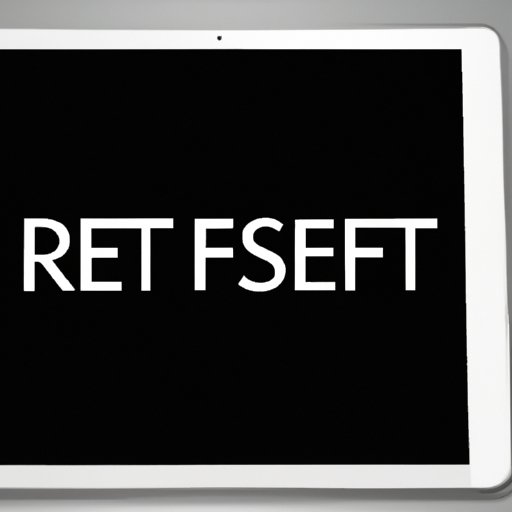
Introduction
There are plenty of reasons why you might want to reset your iPad. Perhaps you’re selling it, passing it down to someone else, or you’re just experiencing some glitches. Whatever the reason, it’s important to know the different methods for resetting your iPad. In this article, we’ll cover everything from quick restarts to complete wipes, and everything in between.
Master Reset: How to Erase Everything on Your iPad and Start Fresh
A master reset is the most thorough way to wipe all the data from your iPad and start fresh. It’s a good idea to backup your data before proceeding with a master reset.
Here are the steps to perform a master reset on your iPad:
- Open the “Settings” app and tap “General”.
- Scroll down to the bottom and tap “Reset”.
- Tap “Erase All Content and Settings”.
- Enter your passcode if prompted, and confirm that you want to erase everything.
- Wait for the process to complete (this can take some time).
- Once your iPad has restarted, follow the prompts to set it up again.
Remember, a master reset will erase everything, so make sure you backup any important data before proceeding.
Quick Restart: How to Soft Reset Your iPad in Just Three Steps
If your iPad is acting up, sometimes a quick restart can solve the problem. A soft reset won’t erase any data, it just shuts down and restarts your device.
Here are the steps to perform a soft reset on your iPad:
- Hold down the power button until the “Slide to Power Off” slider appears.
- Swipe the slider to shut down your iPad.
- Once your iPad is fully powered off, hold down the power button again to turn it back on.
A soft reset is a quick and easy way to troubleshoot minor issues with your iPad.
iTunes Intervention: How to Reset Your iPad Using a Computer
Sometimes it’s necessary to use a computer to reset your iPad, especially if it’s not turning on or responding properly. This method uses iTunes to restore your iPad to its factory settings.
Here are the steps to reset your iPad using iTunes:
- Connect your iPad to a computer running iTunes.
- Open iTunes and select your device.
- Click “Restore iPad”.
- Follow the prompts to complete the restore process.
Be sure to backup your data before restoring your iPad using iTunes to avoid losing your files.
Unresponsive iPad? Try a Hard Reset to Get it Working Again
A hard reset should be used as a last resort. This method should only be used if your iPad is completely unresponsive or frozen.
Here are the steps to perform a hard reset on your iPad:
- Press and hold both the power button and the home button simultaneously for at least 10 seconds.
- Release the buttons when you see the Apple logo appear.
- Your iPad will now restart.
A hard reset can solve more serious issues with your iPad, but it should only be used when all other troubleshooting methods have failed.
Don’t Lose Your Data: How to Reset Your iPad Without Losing Any Files
If you want to keep your data intact while resetting your iPad, there’s a way to do that too. This method will reset the settings on your iPad, but will not erase any of your files or data.
Here are the steps to reset your iPad without losing any files:
- Open the “Settings” app and tap “General”.
- Scroll down to the bottom and tap “Reset”.
- Tap “Reset All Settings”.
- Enter your passcode if prompted, and confirm that you want to reset all settings.
- Your iPad will now reset, but your files and data will remain intact.
Keep in mind that this method will reset all of your settings to their default values, so you’ll need to set everything up again afterwards.
Locked Out? How to Reset Your iPad Password Without iTunes
If you forget your iPad password, don’t panic. There’s a way to reset it without needing to connect to iTunes.
Here are the steps to reset your iPad password:
- Attempt to enter your password incorrectly until you see the “Forgot Passcode” or “Reset Password” option appear.
- Tap “Forgot Passcode” or “Reset Password”.
- Follow the prompts to reset your password.
You may need to enter your Apple ID and password to reset your iPad password, so make sure you have that information handy.
Resetting an Old iPad: Tips for Restoring and Optimizing an Outdated Device
If you’re resetting an old iPad, there are some things you can do to optimize its performance and make it feel like new again.
Here are some tips for restoring and optimizing an outdated iPad:
- Update to the latest iOS version.
- Free up storage space by deleting unused apps and files.
- Turn off features you don’t need, such as Background App Refresh and Location Services.
- Reduce the motion effects and transparency in the Accessibility settings.
- Use a wired connection to transfer large files and backup your iPad to iCloud.
By taking these steps, you can help your old iPad run more smoothly and restore its performance.
Conclusion
Resetting your iPad can solve a myriad of issues, from minor glitches to serious problems. By using one of the methods outlined in this article, you can take control of your iPad and keep it running smoothly.
Remember, a soft reset is usually the best place to start when dealing with issues, but if that doesn’t work, you may need to try a more drastic measure like a master or hard reset. Always backup your data before performing a reset, and follow the instructions carefully to avoid any issues.
Whether you’re resetting an old iPad or just troubleshooting a new device, these tips and tricks will help you get the most out of your Apple tablet.




